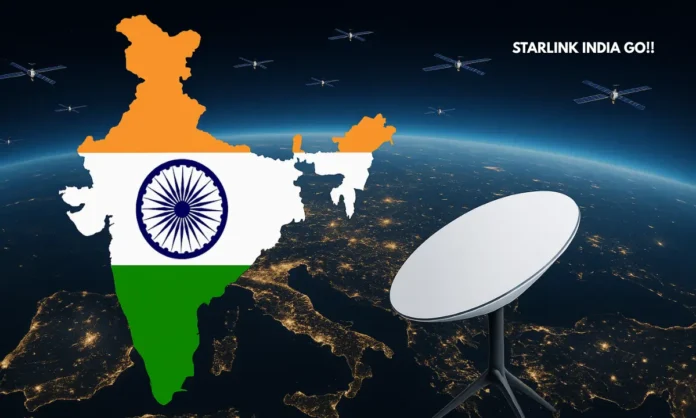Summary
- Elon Musk’s Starlink has received IN-SPACe approval to begin commercial satellite internet operations in India, clearing the final regulatory hurdle.
- The five-year licence makes Starlink the third foreign player approved after OneWeb and Reliance Jio’s satcom venture.
- Starlink must now acquire spectrum, build infrastructure, and comply with India’s security regulations before rollout.
Musk’s India Liftoff: Starlink Finally Cleared for Commercial Orbit
After more than two years of regulatory limbo, Elon Musk’s Starlink is finally set to beam internet services across India. On July 9, 2025, India’s space regulator — the Indian National Space Promotion and Authorization Centre (IN-SPACe) — granted a long-awaited five-year commercial licence to the satellite arm of SpaceX. The clearance positions Starlink as the third satellite internet company to gain India’s trust, joining the ranks of Bharti-backed OneWeb and Reliance Jio’s satellite venture.
The regulatory go-ahead is more than just a bureaucratic milestone. It marks a tectonic shift in India’s broadband ambitions — opening the floodgates to high-speed, low-latency internet in remote corners of the country where fiber optics have failed to penetrate. But Musk’s satellite conquest is not just about market access. It’s also about geopolitics, global spectrum power plays, and the quiet but persistent nudges from Washington.
Starlink, the satellite communication firm owned by Elon Musk, has received regulatory clearance from the Indian National Space Promotion and Authorisation Centre (IN-SPACe) to launch its satellite-based internet services in India.
— Hindustan Times (@htTweets) July 10, 2025
More details 🔗👉 https://t.co/tZBnmBDvMW pic.twitter.com/xUBPUfyDMG
India’s New Satellite Race: Starlink Joins OneWeb and Jio in Orbit
- Starlink’s five-year licence was issued after meeting India’s stringent national security pre-conditions.
- IN-SPACe’s nod makes Starlink the third approved satcom player, after Eutelsat’s OneWeb and Reliance Jio.
- India’s Department of Telecommunications had earlier approved Starlink’s entry in May 2025.
Starlink’s approval follows a multi-tiered compliance path. The Department of Telecommunications (DoT) had given preliminary permission in May 2025 — contingent on Starlink agreeing to India’s updated national security norms. This included rigorous compliance with data routing, encryption, and ground-station localisation norms, all of which Starlink reportedly accepted.
The IN-SPACe clearance comes as India positions itself as a strategic satellite internet hub. With over 800 million internet users but wide rural-urban digital gaps, India’s satellite internet potential is vast. IN-SPACe’s strategy now appears geared towards enabling multiple players to coexist — with OneWeb, Jio, and now Starlink entering a race to connect India’s last-mile users.
India’s space regulator said in a statement that the licence was valid for a five-year period, during which Starlink is expected to complete spectrum acquisition, construct on-ground infrastructure, and begin operations only after field trials prove compliance.
From Tariffs to Telescopes: Washington’s Pressure, Starlink’s Leverage
- U.S. diplomatic cables reportedly show Washington pushed India and other nations to approve Starlink amid Trump-era tariffs.
- Elon Musk, once considered an informal ally of Donald Trump, has benefited from diplomatic soft-power interventions.
- The approval also coincides with broader U.S. interests in securing non-Chinese digital infrastructure footholds in South Asia.
Starlink’s entry also carries an undercurrent of geopolitical maneuvering. As reported by the Washington Post, U.S. State Department cables reveal that the Biden and Trump administrations both quietly encouraged nations — including India — to expedite Starlink approvals. This was particularly visible during bilateral tariff stand-offs where trade cooperation was occasionally tied to Starlink’s acceptance.
Trump, who is now in the thick of re-election campaigning, recently expanded his tariff war to include Canada, Japan, and South Korea. But even as he slapped 35% duties on Canadian imports and 50% on copper, he remained vocally supportive of Starlink’s global expansion. It’s not coincidental that India’s final approval came soon after behind-the-scenes diplomatic engagements that reportedly featured Starlink on the agenda.
The soft power push behind Musk’s satellite fleet aligns with broader U.S. efforts to counter Chinese dominance in digital infrastructure, particularly in the Indo-Pacific. India, wary of Chinese telecom incursions, appears to have reciprocated — clearing the path for an American tech unicorn instead.
The Spectrum Hurdle: Starlink’s Next Mission
- Starlink must still secure spectrum allocation from India’s government before launch.
- Ground infrastructure and security trials remain pending.
- Rollout timelines likely hinge on policy clarity post-2025 monsoon session of Parliament.
The IN-SPACe licence, while critical, is only the beginning. Starlink now needs to obtain spectrum — likely in the Ka-band or Ku-band — which has long been a grey area in India’s policy landscape. Unlike the U.S., where spectrum can be auctioned or allocated administratively, India has yet to define whether satellite spectrum will be auctioned or assigned administratively.
This uncertainty has already delayed operations for other players like OneWeb and JioSat. Until the government provides clarity — expected after the monsoon session of Parliament in late July — Starlink’s full rollout will remain on standby.
Additionally, Starlink is required to demonstrate end-to-end encryption, secure user data routing via in-country ground stations, and prove that its satellites won’t interfere with defence or strategic frequencies — a standard clause for all satcom players operating in Indian airspace.
The Final Frontier for Musk in India?
Elon Musk’s Starlink is finally in orbit — at least on paper. But whether the satellite fleet can actually beam connectivity to Indian villages and border zones depends on resolving some very terrestrial issues: spectrum allocation, policy harmonisation, and navigating India’s labyrinthine telecom regulation.
That said, Musk’s commercial breakthrough comes at a time when India is aggressively digitising its rural belts and ramping up its own satellite capabilities. If Starlink can deliver on its promise — and clear the remaining roadblocks — it may reshape not just how India connects, but who controls that connectivity.
The geopolitical stakes are high. For India, it’s about diversifying its digital infrastructure. For the U.S., it’s about tilting the Indo-Pacific balance. And for Elon Musk, it’s another planet — metaphorically — conquered.


